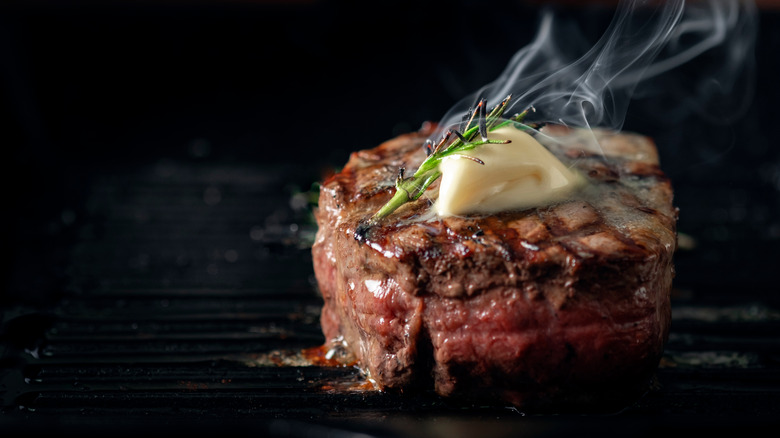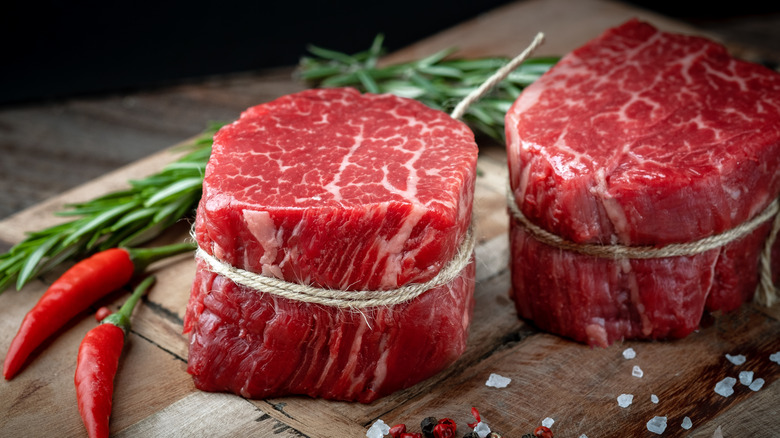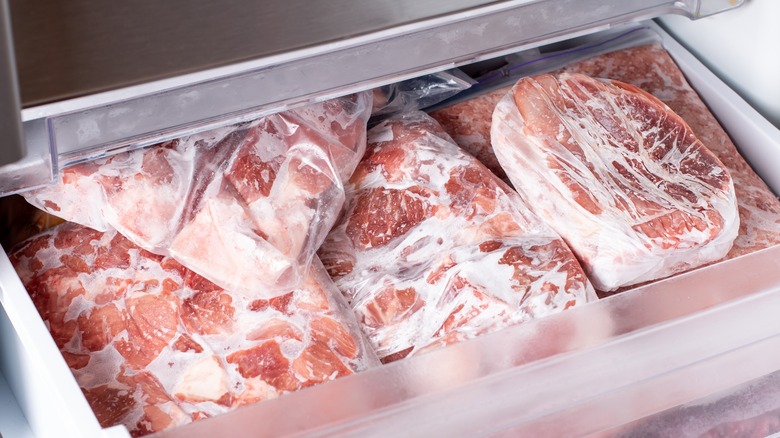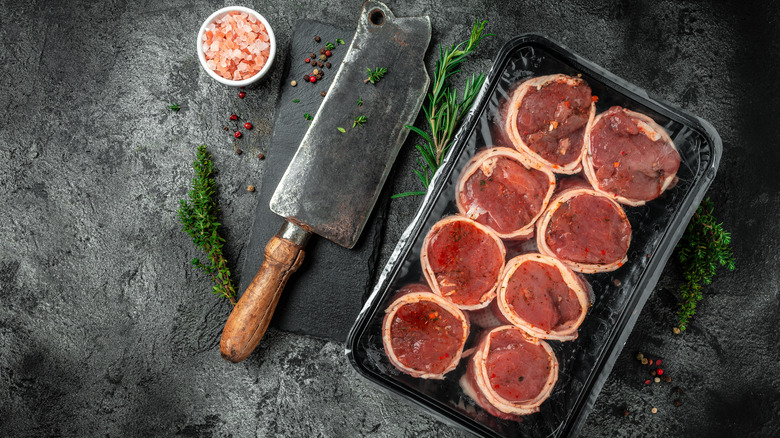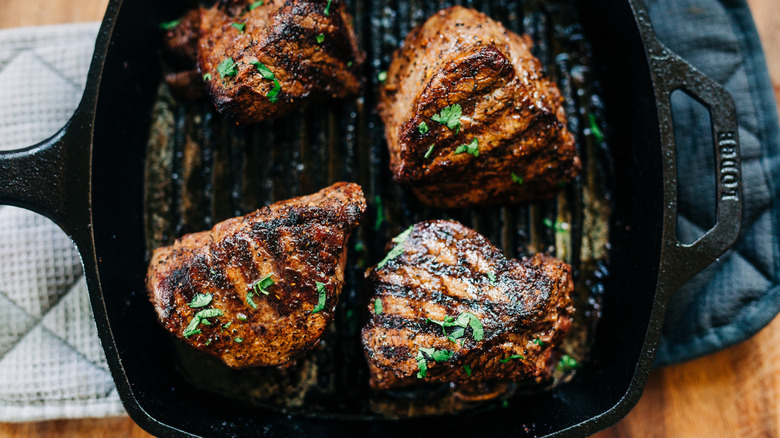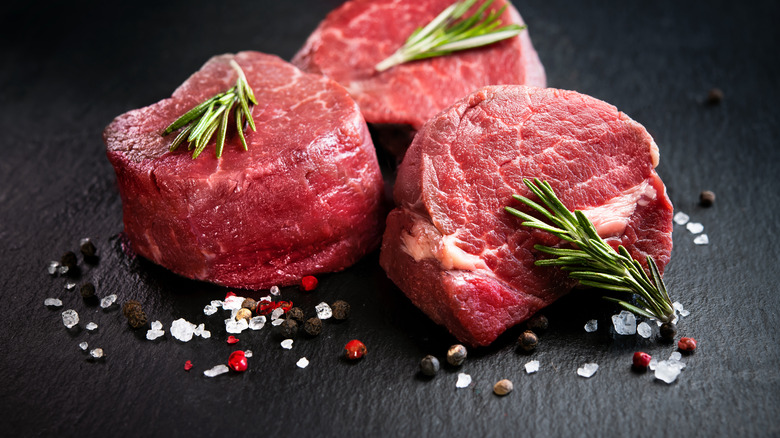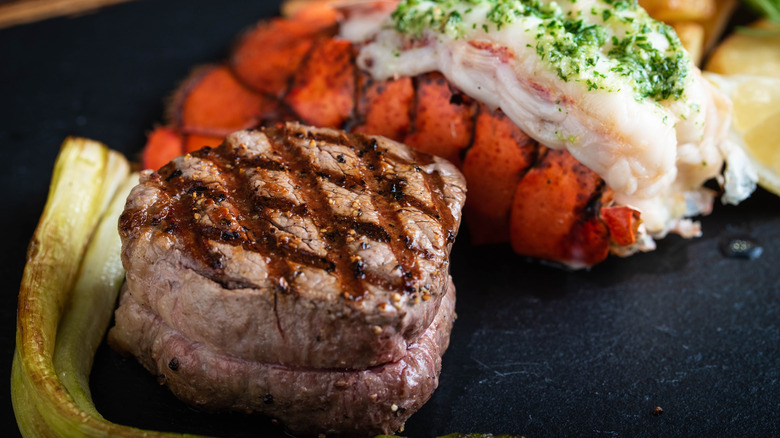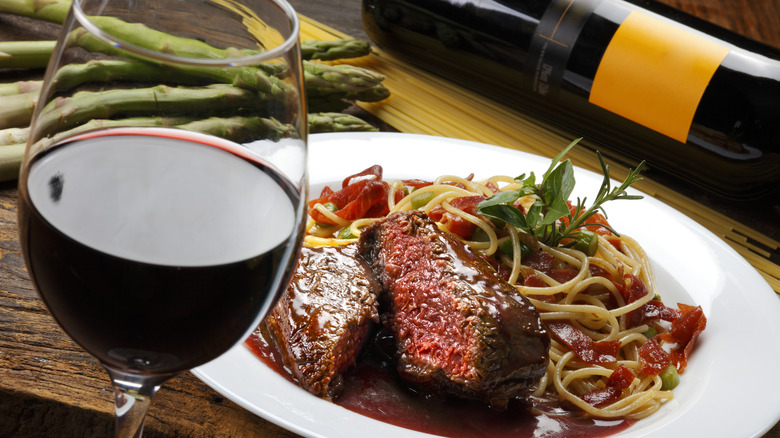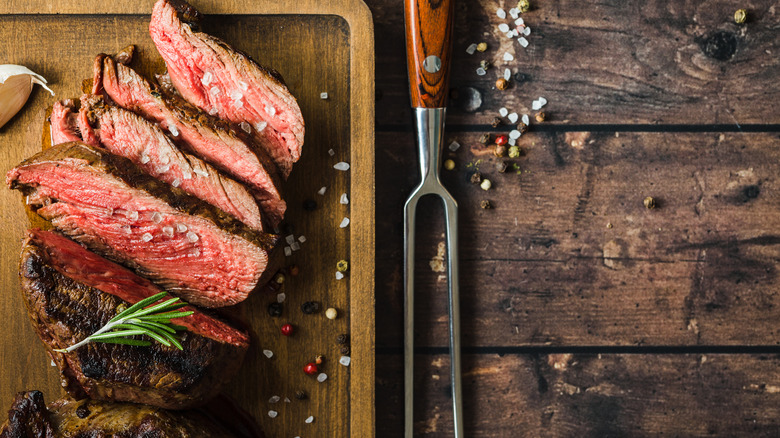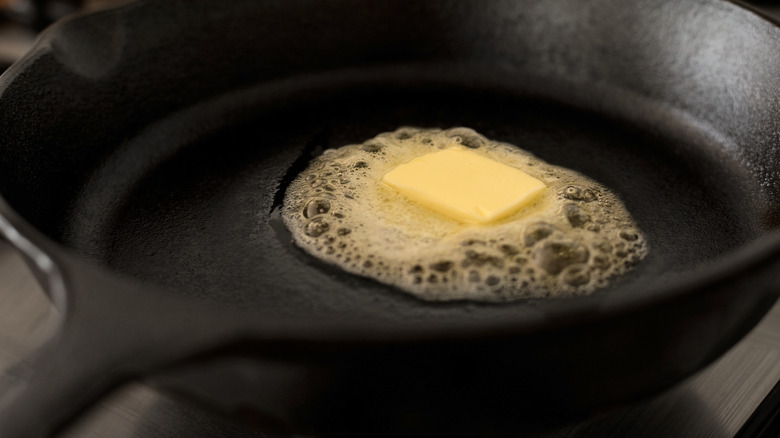Tricks For Cooking A Perfect Filet Mignon Every Single Time
Lean, tender, and full of flavor, it goes without saying that filet mignon is one of the most prized cuts of beef. Just hearing those two words can cause a steak lover's mouth to water. There aren't many things that compare to a perfectly cooked filet mignon, which is why plenty of fans are willing to shell out big bucks for the experience. (According to Omaha Steaks, it's cut from the tenderloin and involves only 2 to 3% of the entire animal, which is one of the reasons why it carries such a high price tag.)
Digging into a filet mignon at your favorite restaurant is always an enjoyable way to treat yourself. Still, learning to cook your own steak at home is also plenty rewarding, not to mention easier on the wallet. Once you've perfected the skill, you can impress friends and family with this elegant culinary delight. Just follow these easy tricks for cooking a filet mignon and it will come out perfectly every single time.
Choosing your filet
The first step to cooking a perfect filet every time starts in the supermarket or butcher shop. Filets are usually 6 to 8 ounces. If you prefer your steak well done, selecting a thinner filet is a better choice so it cooks through easily. A thicker one is more likely to end up with the redness you prefer.
If you aren't used to selecting filet mignon, it can be overwhelming at first. The USDA grades beef according to Prime, Choice, and Select. Prime beef has a lot of marbling (the white fat you see throughout a steak), giving your meat plenty of flavor and tenderness. Choice beef has less marbling but is still a high-quality cut. Select is uniform in quality, leaner than other grades, and tends to lack flavor and juiciness because of its leanness. Regardless of grade, prioritize steaks with a light cherry or deep pink color. If the meat is deep red, it may be an indicator that the beef came from a dairy cow, and you'll be chewing a tough, bland steak (via Weber).
If you're serving filet mignon to a large party, consider buying a whole tenderloin. First remove the silverskin, which is that grayish membrane that covers part of the tenderloin. It's tough to chew and needs to go. Next, cut the tenderloin into four to eight steaks (filets), skipping the tapered ends (you can use them in stew or other dishes).
To freeze or not to freeze?
Is it worth it to stock up on filets when they're on sale and then freeze them? Or is it best to run to the butcher and grab fresh filet mignon every time? If you hear rumors that it's shameful to freeze a good cut of steak, tune them out.
To properly freeze steak, use a couple of layers of protection. A vacuum sealer will help keep out potentially harmful air. If you don't own one, wrap individual filets in plastic wrap or aluminum foil. Then, slide the wrapped steak into a plastic, zip-top bag and seal it up. You can even marinate the steaks if you like. Just skip the aluminum foil or plastic wrap and seal them in two plastic zip-top bags instead, removing as much air as possible. When it's time to thaw the steaks, put them in the refrigerator for 24 hours, with a plate underneath to catch any defrosting drips (via My Chicago Steak).
Bring the filets to room temperature
Whether you've defrosted the filets or are pulling them out of the refrigerator, you need to allow time to bring the meat to room temperature. The reason why you shouldn't cook steak straight from the fridge or freezer is to ensure uniformity in cooking. If you throw a cold meat on the skillet, some areas will cook quicker than others and you may end up with a raw center and overcooked exterior. Plus, if you plan on cooking a filet to rare or medium rare, it may not have a chance to warm up even though it looks done.
To keep meat safe when bringing it to room temperature, leave it out for as short a time as possible. Bacteria grows rapidly and can make you sick, so two hours is the max. If the room is 90 F or more, leave the meat out for no more than one hour (via USDA). If the filet looks gray in color, feels slimy, or has a foul odor, throw it away.
Use a cast iron skillet
You may love your nonstick cookware, but do yourself and your steak a favor and invest in a cast iron skillet for your filet mignon. Cast iron is naturally nonstick and will help to give any steak that crispy sear on the outside. You can put your cast iron right into the oven with the steak in it after you've used it to sear the steak. Not only that, but each time you use it, your skillet gains more and more seasoning, adding additional flavor to your steak (just remember to wash your pan properly).
Cast iron even provides health benefits that your typical nonstick cookware can't offer. Food actually absorbs iron from the cast iron as it cooks. That's good news since iron is needed for healthy red blood cells, neurological development, cellular functioning, and synthesis of some hormones (via National Institutes of Health).
Season steak and sear
Searing involves the same principle of quick scorching — it's high heat and fast cooking. Turning and basting the filet will give it just enough of a sear so that the outside looks beautiful rather than gray and unappealing. Not only does the resulting crust provide flavor and texture, but it also seals in the meat's juices. That being said, the goal isn't to turn out a black, deeply charred piece of meat.
Gordon Ramsay's ultimate tip for searing the perfect steak is to generously season the meat with salt and pepper. Sear your steak in oil or butter for about five minutes per side. That's it. If you have the pleasure of searing a bacon-wrapped filet, the grease from the bacon will take your sear to another level, giving it an extra crispy crust. Keep the heat at a temperature that allows the meat to sear quickly, but also allows the butter or oil not to burn, usually around a medium-high flame on a gas stove. Once your filet is seared on the outside, it's time to get it in the oven to cook on the inside.
Cook in the oven to desired temperature
Rare or well done? It's a never-ending debate and everyone thinks their answer is correct. For those who love a red, slightly cooked steak, there is good news you can arm yourself with when defending your need for a seductively red center filet mignon. According to Y.O. Steakhouse, rare steak contains a higher level of fatty acids and iron, compared to a well-done steak which is cooked longer. Then, of course, there's that succulent, juicy interior. But in all fairness, let's defend the well-done steak fans as well, and all those in between. The goal is to eat your filet mignon in a way that satisfies you and leaves you wanting to do it again. Just make sure that you cook your filet mignon the right way.
Use a meat thermometer to check the temperature of your steak to see if it's done. For rare steak, 125 to 130 F, medium rare, 130 to 140 F, medium, 140 to 150 F, medium well, 150 to 160 F, and well, over 160 F (via The Majestic Restaurant). Put the filet or filets in the 400 F oven, cast iron skillet and all. They'll be done in 3 to 5 minutes and you'll be closer to eating.
Let the steak rest and prepare your sauce
Allowing your meat to rest five to seven minutes after cooking will result in a perfectly cooked, juicy filet mignon. Take your steak out of the oven at about 115 F for a medium-rare steak. It will continue to cook to the right temperature as it rests. Chef Angie Mar tells Martha Stewart, "When meat is hot, the juices are more liquid. When you cut into a very hot piece of meat, all of the liquid is going to come out. If you rest it, it allows everything to relax and redistribute the juices, which creates a more tender, juicier cut."
To check the temperature of your filet, insert the thermometer through the side and make sure the tip is in the center of the meat. While your filet rests, it's time to make a sauce if you desire one. One of the biggest mistakes people make with steaks is not taking advantage of all the useful drippings in the skillet. Butter, herbs, salt and pepper, and anything else you chose to add have all melded together into a glorious, bubbly, concoction. Continue the simmer of this liquid gold and add a bit more butter (because why not) to the mix. For a rich, decadent sauce, a little red wine or cognac will reduce beautifully. Last, finish it up with heavy cream. Add a little at a time until you get the color and texture you want.
Don't forget the sides
There is no question that a filet mignon can stand on its own, but pairing it with the right side (or sides) will take your meal to another level. And let's face it, when you hear the word, "steak," you can't help but think, "potatoes." The two go together like peanut butter goes with jelly. Our creamy Instant Pot mashed potatoes recipe takes about 20 minutes to cook without even turning on the oven. For a quick and easy side, you can never go wrong with a classic basked potato.
If you're in the mood for something green, creamed spinach is a deliciously decadent option while asparagus is always a favorite with filets. A simple roasted asparagus recipe is the best way to bring out its fresh flavor. Grab your asparagus, olive oil, lemon juice, and salt and pepper. While the oven heats to 400 F, rinse and trim the spears, removing about an inch of the base. Lay them on a baking sheet that's been covered in parchment paper. Drizzle the olive oil to coat the asparagus, then squeeze fresh lemon juice over the spears. Last, generously coat it all with salt and pepper. Roast in the oven for 20 minutes and voila — perfect asparagus. Hint: the asparagus can roast while you prepare your sauce for the filet.
Choose the perfect wine pairing
When it comes to steak, there simply isn't a finer beverage pairing than red wine. With so many options though, how do you choose? Cabernet Sauvignon is typically the go-to when it comes to wine and steak. There's good reason for the pairing: just like steak, cabs are big and bold. For filet mignon, however, there are options you should consider. "Softer cuts of steak like filet mignon or porterhouse are best with wines like malbec," Anna Maria Kambourakis, a certified sommelier and wine blogger at Unraveling Wine, told Tasting Table. The fruity palate of the malbec, along with its richness and tannins, partner with a filet without overwhelming it.
Another red wine that pairs well with leaner cuts such as filet mignon is Touriga, which comes from the Touriga Nacional grape in Portugal. "The fruit character on it is dark-fruited, with some serious plushy tannin," Michele Gargiulo, Certified Sommelier, Certified Specialist of Wine, Executive Bourbon Steward, and Certified Sake Advisor, told Tasting Table. It is structurally like Merlot but more earth-driven." In the end, you can try wine recommendations, but be sure to always drink what tastes best to you.
Save the leftovers
Although filet mignon is best served fresh out of the oven, you can save the leftovers so it doesn't go to waste. The trick is to store leftovers properly. If you used plenty of butter during the cooking of your filet, you're ahead of the game. Butter gives the lean filet cut the extra fat it needs to stay juicy and tender. That will help you're your leftover filet stay moist.
It's recommended that you store your cooked steak in the refrigerator within two hours of cooking it (via Still Tasty). That shouldn't be a problem since the goal is to serve your steak hot and eat it. When stored properly, your filet can stay in the refrigerator for three to four days. If you'd like to freeze it, you can store your steak in an airtight container or freezer bag and freeze it for up to two or three months.
There's no need to waste all the hard work you put into cooking a steak. However, the chance of leftovers is slim to none, when using a few tricks for cooking the perfect filet mignon.
Add butter and seasonings
Looking for a simple trick to get a better filet mignon? Just add butter. Filet mignon is famous for being lusciously tender and is often described as cutting into a piece of butter. This stems from the fact that it's cut from an area where there's very little muscle, so it doesn't get tough. Still, the meat can dry out when cooking because of its lack of fat. Enter, butter.
Once the cast iron skillet is nice and hot, add enough butter to the pan to allow for basting the filet while it sears. This will help it remain moist and give your filet additional flavor that only butter can give. You may use oil, as some cooks prefer, to sear the steak, but then add butter as it sears for basting and decadent richness. You can also add herbs and spices for a boost of flavor — garlic, onion, and rosemary are popular options.
